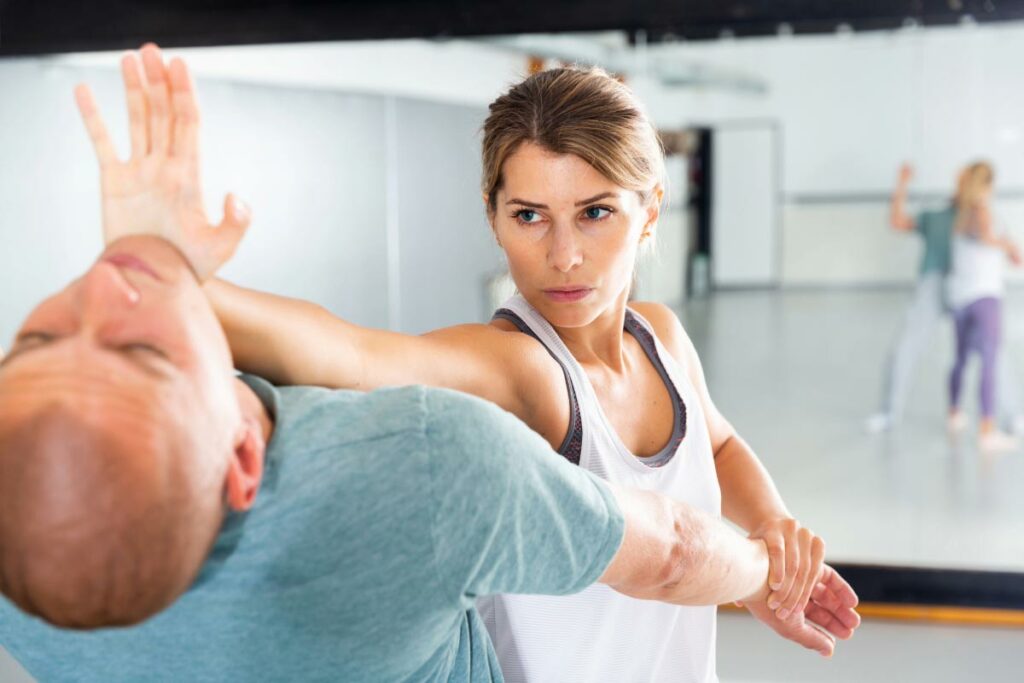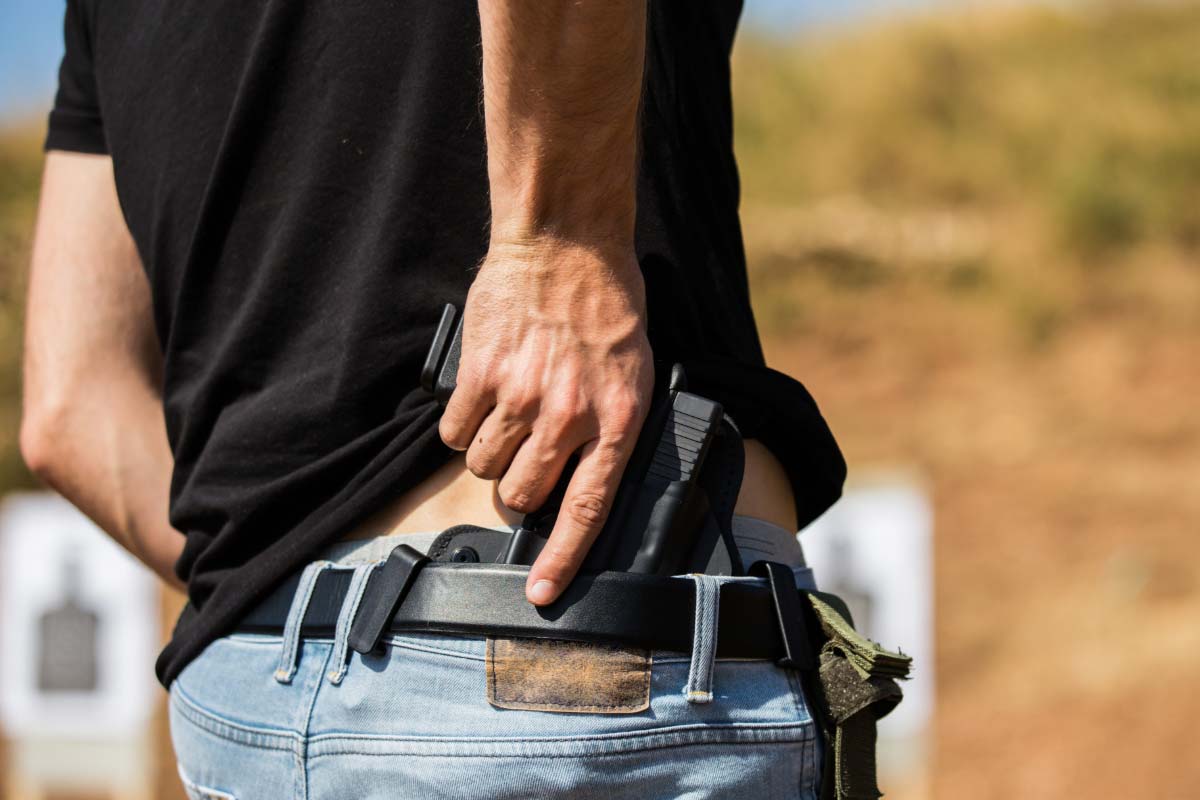Self-defense is not all about about how strong you are or how well you can throw a punch. Learning how to properly execute defensive techniques is important. Just as important is thinking strategically, staying alert, and being prepared.
In this article, we’ll cover some basic concepts along with some techniques that everyone should know to enhance their safety.
This article covers:
- Understanding the Basics of Self-Defense
- Self-Defense Techniques and Strategies
- Practical Self-Defense Training
- Defense Against Common Attacks
- Self-Defense Considerations for Specific Groups
- Self-Defense Legislation and Ethics
- Physical and Mental Conditioning for Self-Defense
- Dealing with Specific Scenarios
Understanding the Basics of Self-Defense
Before delving into tactics and techniques, one must grasp the essential principles underlying self-defense. These include not only physical moves but also the mental preparation and situational awareness needed to avoid or address threats.
The Importance of Awareness and Prevention
One’s safety often begins with awareness—being attuned to their environment and the behavior of those around them.
This preventative stance is the first line of defense and involves identifying potential threats before they escalate into physical confrontations. It requires a commitment to always observe one’s surroundings and the development of an intuition that can signal danger.
Prevention also encompasses lifestyle choices such as avoiding known dangerous areas and times when risk is elevated.
Be aware of your surroundings. Stay alert. It’s also important to appear alert.
Developing a Self-Defense Mindset
A self-defense mindset is built on both a fighter’s mentality and a survivor’s mentality. This means fostering a sense of confidence and assertiveness that can dissuade attackers.
Someone that is appears alert and walks with confidence is significantly less likely to be attacked.
Preparation includes both mental and physical responses, cultivating the readiness to act decisively if a threat arises.
Training can reinforce health and resilience, which also improves one’s ability to handle a physical altercation. Obviously it’s better to have size, power, and strength. But ultimately, self-defense is less about physical prowess and more about the determination to protect oneself by whatever ethical and legal means necessary.
Self-Defense Techniques and Strategies
Practical self-defense knowledge empowers individuals to protect themselves in threatening situations. Knowing specific techniques and strategies is crucial for effective personal defense.
Understand Basic Striking Surfaces
Every individual should master a few basic self-defense moves to increase their chances of safety in most confrontations.

As a simple example, the palm-heel strike can be very effective. A person drives the base of their palm up and into the attacker’s nose, chin, or throat with force. This technique require minimal training but can be powerful tools to incapacitate an assailant temporarily. You can learn to do this much easier than throw a technical punch. It’s also a lot safer for your hands.
Targeting Vulnerable Areas
Krav Maga and similar self-defense training often emphasizes targeting the attacker’s vulnerable areas, such as the eyes, nose, throat, and groin.
A quick eye strike can be done by jabbing with fingers. You could even use a pen or your car keys.
To perform a knee strike, bring the knee up forcefully against the attacker’s groin, potentially causing enough pain and surprise for one to escape.
These targeted attacks can make a significant difference despite one’s size or strength.
Escape and Evasion Tactics
In any threatening scenario, identifying an escape route is a priority.
If engaged, striking vulnerable areas provides an opportunity to flee.
Self-defense skills like a front kick to the groin or a hammer strike using keys or other objects can give one the crucial moment needed to break away.
Remembering general safety tips, such as remaining aware of one’s surroundings, can often prevent a situation from escalating to physical conflict.
Situational awareness is key. Be aware of your exits. Strategically position yourself to keep potential danger in plain sight.
Practical Self-Defense Training
Practical self-defense training equips individuals with the skills necessary to protect themselves in a range of situations. It requires dedication and consistent practice to master the techniques effectively.
However, just a few lessons and understanding basic techniques can go a long way.
Martial Arts and Self-Defense Classes
Enrolling in martial arts or self-defense classes can provide a structured learning environment for developing self-defense skills.
Classes often cover a range of disciplines, including, Krav Maga, Kickboxing, Muay Thai, and Boxing.
Each martial art contributes to building a strong core, enhancing strength, cardio, balance, and speed. Various disciplines will specialize in different situations such as standing and striking at a distance or grappling and fighting on the ground.
For example, Brazilian Jiu-Jitsu focuses on ground fighting and submission holds, teaching how to control an opponent. While almost every fight starts standing on the feet, most fights also quickly end up on the ground.
Therefore, understanding how to fight off your back and learning to get up is a crucial skill.
Meanwhile, Judo emphasizes throws and takedowns, which can be essential for self-defense.
If you want to accelerate your learning, sign up for private self-defense lessons or find an instructor that can tailor training to your specific needs and goals.
Importance of Regular Practice and Sparring
To ensure self-defense techniques become second nature, regular practice is important.
Through repetition, the body memorizes movements (aka developing “muscle memory”), allowing for quicker reactions during unexpected confrontations and under extreme duress.
Sparring is a component of some disciplines such as MMA, but should also be emphasized in self-defense classes.
This is necessary for simulating real-life scenarios to better understand timing and distance management as well as developing your reactions.
In Krav Maga training, stress drills are commonly used mimic the chaos and pressure of an attack, training individuals to remain calm and respond effectively.
Training across different martial arts such as Wrestling and Boxing provides a comprehensive skill set, allowing one to control where the fight takes place. These disciplines make a well-rounded figher by also integrating strikes, defensive blocks, and evasive maneuvers into muscle memory.
Defense Against Common Attacks
Knowing how to respond effectively in a dangerous situation can mean the difference between escaping unharmed and being a victim of an attack.
The following subsections provide strategies for defending against unarmed and armed assailants, emphasizing fundamental self-defense moves designed to enable an individual to get away from an attacker.
Defending Against Unarmed Assaults
In confronting an unarmed attacker, one’s goal is to create an opportunity to escape. For example, the heel-palm strike is a recommended technique for safely hitting an attacker and reducing the risk of injury to oneself. By striking vulnerable areas such as the eyes, nose, or throat, a person can temporarily disable the assailant and gain crucial seconds to get away. Additionally, simple maneuvers like crouching down can help one break free if grabbed from behind.
Surviving Attacks by Armed Assailants
Facing an assailant with a weapon necessitates a heightened level of caution. When the opportunity arises, aiming for sensitive spots on the attacker’s body, such as eyes or groin, can provide a chance to escape.
It’s critical to note that if disarming the assailant is not a viable option, the best course of action might be to comply with their demands, especially if they have a deadly weapon.
Regardless, awareness of one’s surroundings and having a plan to quickly locate exits or draw attention for help can be instrumental in surviving dangerous situations.
Self-Defense Considerations for Specific Groups
Self-defense strategies can vary significantly across different groups due to varying physical strengths, sizes, and societal challenges. Recognizing the unique risks and tailoring techniques to effectively address them is key for enhancing personal safety.
Women’s Self-Defense
Women often face specific threats, such as assault or rape, from attackers who may perceive them as more vulnerable.
To counteract situations where a woman might be grabbed in a bear hug or similar hold, it is essential to practice techniques that focus on leverage and striking vulnerable points on the attacker’s body.
One such method involves using the base of the palm to strike the nose or the heel of a foot to stomp on the assailant’s instep.
Additionally, awareness and trust in one’s instincts play a crucial role in women’s self-defense. They should be encouraged to assertively set boundaries and vocalize them to deter potential attackers, especially strangers.
Self-Defense for Children and Teens
Children and teens require self-defense knowledge that applies to their age, size, and strength.
Teaching them about boundaries and the importance of saying no to unwanted approaches is fundamental.
Physical techniques for younger individuals often emphasize escaping holds and running to safety, rather than confronting an assailant.
Coaching them to use loud verbal alerts such as yelling “Stop!” or “Help!” draws attention and can dissuade an assailant.
Additionally, they must be informed about scenarios involving strangers, including the common lures used by potential kidnappers.
Self-Defense Legislation and Ethics
Self-defense laws vary by jurisdiction, but they generally allow for reasonable force in response to imminent harm. Ethics provide a framework regarding the moral implications of self-defense actions.
Understanding the Law and Your Rights
Every individual should know their legal rights when it comes to self-defense.
These rights often involve the use of force if one reasonably believes they are in immediate danger.
For instance, if someone is experiencing an attack, they should promptly call 911 for help while also taking necessary measures to protect themselves according to the law.
Important distinctions exist between states: some have a “stand your ground” policy, while others require a “duty to retreat” before using force.
Using Force Appropriately in Self-Defense Situations
In self-defense situations, the use of force must be proportional to the threat.
Using more force than necessary may lead to legal consequences.
Ethics play a crucial role in determining appropriateness, steering individuals to consider the minimal necessary action to ensure safety.
Resisting an aggressor should be guided by both legal and moral considerations, balancing one’s rights against the imperative of minimizing harm.
Physical and Mental Conditioning for Self-Defense
Effective self-defense encompasses more than just physical techniques; it includes physical and mental conditioning. Proper conditioning can improve one’s strength, enhance health, and sharpen instincts, all of which are crucial in a self-defense scenario.
Building Strength and Agility
One’s physical capability to defend themselves effectively is rooted in their strength and agility. A consistent regimen of exercises like squats, push-ups, and lunges not only builds muscle but also enhances the body’s capability to move quickly and efficiently in response to a threat.
Boxers like Mike Tyson exemplify the power of strength training, revealing the benefits of a robust physique in defensive situations.
Moreover, agility drills, which may involve cone drills or ladder drills among other exercises, will help to improve your movement.
Agility enables individuals to dodge attacks and position themselves advantageously, making it a vital aspect of self-defense.
Improving Reflexes and Instincts
Beyond physical prowess, developing sharp reflexes and instincts is essential. Reflexes are honed through activities that require quick responses, such as sparring or reaction ball training. These activities condition one’s body and mind to react swiftly to aggression.
Instincts, on the other hand, are sharpened through realistic scenario training where individuals engage in simulated confrontations. This type of practice can help one assess threats and respond appropriately without hesitation.
Constantly improving these areas is crucial, as one’s ability to instinctively recognize danger and react promptly could be lifesaving.
Dealing with Specific Scenarios
In self-defense, one must tailor their approach to specific threats. Understanding the dynamics of the scenario helps in selecting the most effective means of defense and escape.
Self-Defense Against Multiple Assailants
When facing multiple attackers, the primary goal is to escape without engaging in a prolonged conflict.
Once again, awareness plays a crucial part here. One should always be conscious of their environment and possible escape routes.
It’s essential to keep moving to avoid being surrounded or cornered by creating distance between oneself and the assailants. The concept of stacking opponents inline is a very effective technique.
If one must engage physically, quick and decisive strikes to vulnerable areas can incapacitate attackers momentarily, allowing for an opportunity to get away.
What self-defense concept do you think everyone should know? Leave a comment below.







